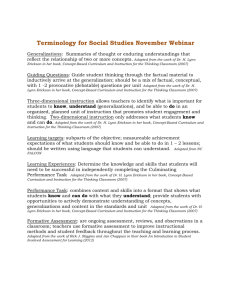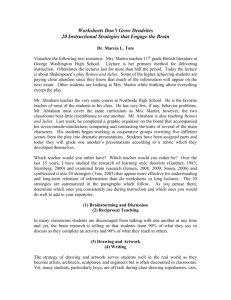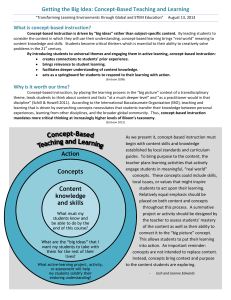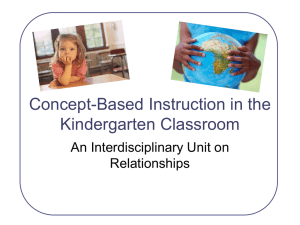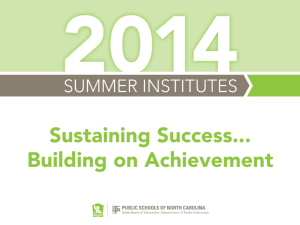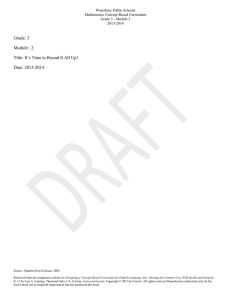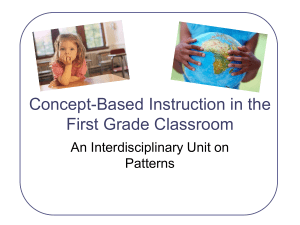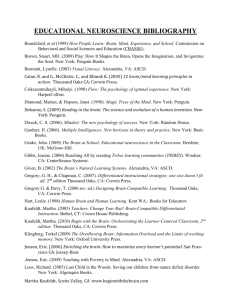Concept Based Instruction PPt. - OA & BCIG Community School
advertisement
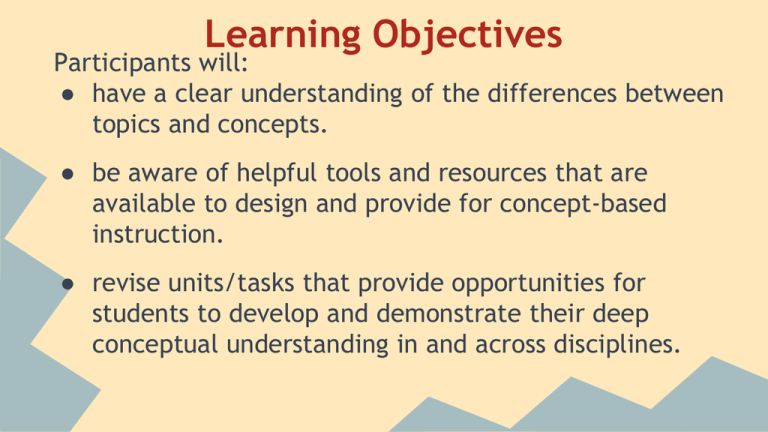
Learning Objectives Participants will: ● have a clear understanding of the differences between topics and concepts. ● be aware of helpful tools and resources that are available to design and provide for concept-based instruction. ● revise units/tasks that provide opportunities for students to develop and demonstrate their deep conceptual understanding in and across disciplines. Pre-Assessment As a table group, write your understanding and/or definition to the following question. What does conceptual learning look like? Building Background Knowledge Understanding the Why Common Language Definitions Building Background Knowledge Erickson pages 7-8 and 10-11 Why is the conceptual transfer of knowledge a key indicator of deeper understanding? Do you lead your students through a twodimensional or three dimensional learning experience? Topic/Concept Sort Table Group Activity Each table has an envelope with words. Determine whether it is a concept or topic. Topic: a set of facts related to specific people, places, situations, or things. Concept: an idea that provides structure for learning with examples that share common attributes. It is: timeless universal/transferable abstract broad Think Aloud Model Modeling how to change a topical lesson to a conceptual lesson Model Lesson: Tornadoes Grade: 4 Subject: Science Objectives: 1. Research facts about tornadoes 2. Present information about tornadoes. 3. Show a demonstration of a tornado through an activity, animation, etc. NGSS Standard: 4-ESS3-2 Generate and compare multiple solutions to reduce the impacts of natural earth processes on humans. Iowa Core Concepts/Skills Earth and Space (Grades 3-5) understand and apply knowledge of weather and weather patterns. Topic: a set of facts related to specific people, places, situations, or things. Concept: an idea that provides structure for learning with examples that share common attributes. It is: timeless universal/transferable abstract broad Lesson: Big Idea/Concept The interaction of natural disasters and humans. Essential Understandings (Generalizations) 1. A variety of natural disasters result from natural processes. 1. Humans cannot eliminate the natural disaster but can take steps to reduce their impacts. 1. Human communication and designing of man-made structures is used to ensure the safety of society. Performance Tasks/Skills 1. Students may choose one type of natural disaster that best illustrates their point of view on how society might be affected by this type of disaster. 2. Students will identify solutions and determine the cause and effect from natural disasters. Performance Tasks/Skills 3. Students will create ideas/plans for improvements to decrease the impact on society from natural disasters; in doing so, this might change how disasters affect society. 4. Students will conclude with comparing and contrasting their ideas/plans to improvements to decrease the impact on society to determine the best solution. Resources Conley, D. T. (2013). Getting Ready for College, Careers, and the Common Core What Every Educator Needs to Know.. Hoboken: Wiley. Erickson, H. L. (1998). Concept-based curriculum and instruction: teaching beyond the facts. Thousand Oaks, Calif.: Corwin Press. Erickson, H. L. (2007). Concept-based curriculum and instruction for the thinking classroom. Thousand Oaks, Calif.: Corwin Press. Resources Erickson, H. L. (2009). Facilitators' guide: stirring the head, heart, and soul : redefining curriculum, instruction, and concept-based learning (3rd ed.). Thousand Oaks, Calif.: Corwin Press. Lanning, L. A. (2013). Designing a concept-based curriculum for English language arts meeting the common core with intellectual integrity, K-12. Thousand Oaks, Calif: Corwin Press, Inc.. McTighe, J., & Wiggins, G. P. (2004). Understanding by design: professional development workbook. Alexandria, Va.: Association for Supervision and Curriculum Development. Resources Wiggins, G. P., & McTighe, J. (2005). Understanding by design (Expanded 2nd ed.). Alexandria, VA: Association for Supervision and Curriculum Development. Concept-Based Curriculum and Instruction Website (NWAEA)

